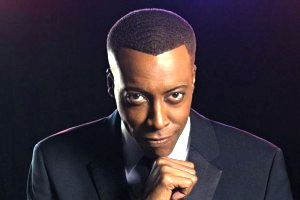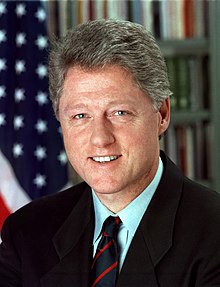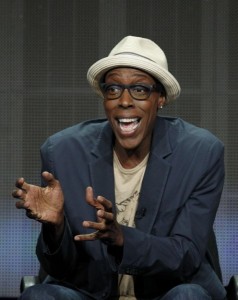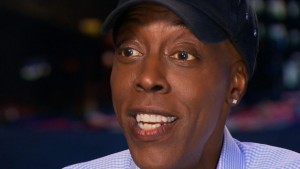The Arsenio Hall Show

Madonna on the Arsenio Hall Show (1990, full original appearance)
Madonna appears on the Arsenio Hall Show to promote Dick Tracy and make Arsenio sweat about Paula Abdul, etc.
 The Arsenio Hall Show is an American late-night talk show, created and hosted by comedian and actor Arsenio Hall that premiered on September 9, 2013 in syndication. The show had previously aired in syndication from January 3, 1989 to May 27, 1994. The current series is considered to be a revival of the original. The original Arsenio show was distributed by Paramount Domestic Television and taped at Paramount’s studios in Los Angeles. The current program is produced at Sunset Bronson Studios in Los Angeles and distributed by PDT successor CBS Television Distribution.
The Arsenio Hall Show is an American late-night talk show, created and hosted by comedian and actor Arsenio Hall that premiered on September 9, 2013 in syndication. The show had previously aired in syndication from January 3, 1989 to May 27, 1994. The current series is considered to be a revival of the original. The original Arsenio show was distributed by Paramount Domestic Television and taped at Paramount’s studios in Los Angeles. The current program is produced at Sunset Bronson Studios in Los Angeles and distributed by PDT successor CBS Television Distribution.
Original run (1989–1994) Background
Hall had been a host on The Late Show, another talk show on Fox, after the dismissal of Joan Rivers. He was given a 13-week run, during which he became unexpectedly popular. During the monologue of his final appearance as host, Hall stated that the reason he had agreed to only do 13 weeks was because that was as long as he was able to stay, as he had plans “to do other things.” He subsequently began working on the Eddie Murphy vehicle Coming to America. He ultimately signed with Paramount Television before Fox finally decided, too late, that they wanted to keep him. Hall had a fairly long connection with Paramount before this, having been the in-house comedian on Paramount’s weekly music series Solid Gold for several years and serving as a co-host for its final two years.
One of the show’s recurrent gags is affixing a humorous label to a section of the studio audience that is in a seating block left of band’s stage, called the “Dogpound” or “dog pound.” Members of the Dogpound jubilantly interacted with Hall, standing up and making a pumping, whirling motion with their raised fists and howling “Wuff, Wuff, Wuff”. The labeling is a staple of Hall’s opening monologue and almost always begins with the phrase “People who….” In one variation of the gag, Hall designates this section as “People who are currently in a Witness Protection Plan,” at which point a camera pans over to that section to reveal a digitally pixillated view of the audience that made it impossible to identify them.
Although not an actual “gag”, Burton Richardson‘s long intro of the show’s host (in which he holds the “O” in “Arsenio” for as long as ten seconds right before Hall came out onto the stage, then, in the same breath, finally announce “HALL!”) is a staple of the show. In the intro to the final episode, Richardson held his one-breath introduction for exactly twenty seconds, one of the few times he had done so.
A frequent gag in Hall’s opening monologue suggests that he still lives in Cleveland and drives himself to Los Angeles every day to host the show. While on these alleged long drives, Hall ponders certain thoughts, referring to them as “things that make you go hmmm….” This running gag inspired a 1991 C+C Music Factory song by that very title. “Things That Make You Go Hmmm…” reached #1 on the Billboard Hot Dance Club Play chart, and #4 on the Billboard Hot 100 chart.
Hall’s show was aimed primarily at the younger urban audience, with Eddie Murphy (a personal friend of Hall’s) and other performers often featured. Other semi-regular guests who were on The Arsenio Hall Show included Andrew “Dice” Clay and Paula Abdul. The show quickly appealed to young people of all races and began to attract a wide variety of guests (although this popularity with audiences was short-lived, leading to the show’s cancellation). It became the show for entertainers to go to in order to reach the “MTV Generation.”
The show was known for the audience’s chant of “Woof! Woof! Woof!” while pumping their fists in a circular motion. Some say this was appropriated from the fan chants at Hall’s hometown team of Cleveland Browns games. Others have speculated that it came from the chant of Black Greek Letter Organization Omega Psi Phi fraternity. In any case, it quickly became associated with Hall’s show and with Hall himself. Arsenio was also well known for his long fingers, and it became a long-running gag including some episodes on In Living Color.
Hall’s friend M.C. Hammer was a frequent interview and musical guest. He also interviewed “Jason Voorhees,” the main character from the popular Friday the 13th series of films around the time of the release of Friday the 13th Part VIII: Jason Takes Manhattan. Muppets creator Jim Henson also appeared on the show 12 days before his death in May 1990, marking one of Henson’s last public appearances. Hall also often featured World Wrestling Federation wrestlers, like Hulk Hogan (who first denied using steroids on the program), Ravishing Rick Rude (who made a special set of tights with Hall’s face on the back) with Bobby Heenan, Randy Savage, Bad News Brown, the Big Bossman and Akeem with Slick, and the Ultimate Warrior.
In 1990, Hall decided to develop a companion program to his own as what he termed to be his show’s “afterparty”. This idea became The Party Machine, a thirty-minute late night music show in the same vein as shows like Club MTV or Soul Train. Hall co-produced the series with its host, singer/actress Nia Peeples, and it debuted on January 7, 1991 in syndication (usually following its parent series). Although initial ratings were high, especially in its larger markets, The Party Machinebegan sliding in the ratings quickly and the program was cancelled five months after its debut. Its final episode aired on September 15, 1991.
Queer Nation incident
During a May 1991 taping, three or four members of Queer Nation, seated in the back row in different sections of the audience, interrupted Hall’s opening monologue demanding to know why he never had any gay guests on the show. Hall’s initial answer was that since most of the guests were not open about their sexuality, neither Hall nor the producers knew whether they were gay or not.
When the protesters voiced their offense because the show failed to book filmmaker Gus Van Sant (whose My Own Private Idaho was in production at the time) or actor Harvey Fierstein, Hall defended the show by saying that Elton John had been a guest. Increasingly infuriated, Hall added that he booked guests due to his interest in what they were working on at the time, not because of their sexual preference (specifically, in the case of Fierstein, saying that if he was doing something that Hall found interesting, he would definitely book him as a guest). The heated exchange went on for several minutes, and Hall continued to defend himself as both a comedian and a host, pointing out that he also had gay friends, and that a person’s sexual preference was really nobody else’s business. Fierstein eventually did become a guest on the show months later.

Bill Clinton 42nd President of the United States
Then-presidential candidate Bill Clinton was a guest on the show in June 1992, playing “Heartbreak Hotel” on the saxophone (causing Arsenio to quip, “It’s nice to see a Democrat blow something besides the election”). The appearance is often considered an important moment in Clinton’s political career, helping build his popularity among minority and young voters; Clinton went on to win the election in November 1992.
The popularity of the former president’s appearance on the show was rekindled, however, on June 6, 2012; when a mashup of his iconic sax solo, set to the tune of M83‘s “Midnight City“, was uploaded to YouTube; instantly going viral and creating buzz all over the web.
Eventual decline and cancellation
The program remained popular into 1993; but as the year went on, Hall and Paramount began having ratings problems due in large part to the premiere of three late-night series before the year was out.
At the end of the 1992-93 season one of Hall’s strongest bases consisted of CBS affiliates. At the time, CBS did not offer much in the way of late night programming other than its nightly crime drama rerun block and its overnight newscast CBS News Nightwatch (later replaced by Up to the Minute). Among the CBS stations that aired Arsenio at the time were WJW-TV, then the network’s affiliate in Hall’s hometown of Cleveland; and WBBM-TV in Chicago, one of the network’s owned-and-operated stations. Another prominent group of stations that carried the program were affiliates of the still-young Fox, many of which picked up Arsenio to fill the gaps left when The Late Show, which never was able to find an audience, was finally canceled in 1988; this group included at least one Paramount-owned Fox affiliate, WTXF-TV in Philadelphia.
In the summer of 1993, David Letterman, who had spent over 13 years at NBC and the previous 11 as the host of the popular post-Tonight Show program Late Night, left the network due to his dissatisfaction with being passed over for The Tonight Show hosting gig after the retirement of Johnny Carson in favor of Jay Leno. Letterman signed with CBS to do a late-night program which would compete head-to-head with The Tonight Show. This caused a problem for Hall, who had found himself in a similar situation before when his program first premiered. At the time, Carson’s program was the only network program airing in the post-local-news time-slots nationwide.
While Paramount was set to launch Arsenio in syndication, CBS was ready to premiere The Pat Sajak Show, which was to have Wheel of Fortune host Pat Sajak preside over a 90-minute-long program similar to Carson’s. However, Hall had two things working in his favor; his prior late-night hosting experience when compared with Sajak’s lack of emceeing outside of hisWheel duties, and the fact that his show was to premiere exactly one week before Sajak’s to give him a head start. Many CBS affiliates—including WBBM-TV and WJW—picked up Hall’s show when The Pat Sajak Show was canceled within 12 months of its debut. This time however, instead of facing an unproven entity, Hall was facing one of the most popular hosts in late night, with the new Late Show with David Letterman becoming an instant hit. Hall lost many CBS affiliates when Letterman’s new show debuted. Most, if not all, of the rest dropped Hall when Letterman’s show became a runaway hit. Arsenio also found itself losing some of its audience to cable as MTV launched a daily thirty minute late-night program that was hosted by comedian Jon Stewart. The new Jon Stewart Show was an instant success, quickly becoming the second most popular show on MTV behind Beavis and Butt-head shortly after its summer 1993 premiere.
Subsequently, Fox decided to get back into the late night television battle after several years, despite Arsenio drawing solid ratings on many of its affiliates. In September 1993, the network premiered The Chevy Chase Show running directly against Leno and Letterman. Fox refused to let its affiliates preempt the show, forcing the Fox affiliates airing Arsenio to either drop the series or move it to an undesirable later time slot. This caused another ratings slide, which was not helped by the rapid failure of The Chevy Chase Show, which was canceled after less than a month on the air. After its cancellation, many of the Fox stations that had aired Arsenio chose to put other programming in the slot, and Hall could not get the timeslots back in all cases.

Although the show’s sharp ratings decline in 1993 was due largely to circumstances beyond Hall’s control, Paramount was running out of patience by the start of 1994. The purported final straw came in February 1994, when Hall booked controversial Nation of Islam leader Louis Farrakhan to appear on the show. Despite a press release saying that Hall would have other guests appearing the night of Farrakhan’s appearance, Hall instead allowed Farrakhan almost the entire sixty minutes to be interviewed. The scheduled performance of gospel group Kirk Franklin & The Family was relegated to the very end. The backlash from the appearance caused a further ratings drop from which the show never recovered. On April 18, Hall and Paramount mutually agreed to end the show. Its last episode aired on May 27.
Shortly before Arsenio was cancelled, Paramount’s merger with Viacom was finalized. Since this now meant that Paramount and MTV were corporate siblings, there now was a talk show ready to replace Hall’s and, after some reworking and an expansion to sixty minutes, The Jon Stewart Show became that replacement for fall 1994. Although Stewart was able to gain spots on many of the same stations that were airing Arsenio at the time, the syndicated Jon Stewart Show did not carry over the popularity from MTV and was cancelled in 1995 for poor ratings. Paramount’s 1998 attempt at a daily variety show, The Howie Mandel Show, also failed and the company did not try again before its TV operations were merged with CBS’ in 2006.
Revival (2013)
On June 18, 2012, Hall and CBS Television Distribution (which now owns the Paramount Television library) signed a deal to produce a new late-night talk show. This debuted on September 9, 2013. The new program airs on stations owned by groups such as CBS Television Stations, Tribune Broadcasting (which also co-produces the program) and Local TV, including stations that also carried Hall’s original program, such as KCPQ in Seattle and KBCW in the San Francisco Bay Area. Stations that air the revived program include KTLA in Los Angeles, KDAF in Dallas-Fort Worth, WPIX in New York City, WGN-TV in Chicago, WUCW in Minneapolis-Saint Paul, and WDCW in Washington, D.C..
Unlike Hall’s previous show, this version is taped at the Sunset-Bronson Studios in Hollywood, whose lot houses KTLA.
In a 2012 interview with Essence Magazine, Hall stated that he would like to interview Mariah Carey, as she only appeared as a featured performer on his show in 1990.
The debut episode beat out all late night shows in viewership that evening. However, after its premiere week in September 2013, the ratings dropped. In mid-October, executive producer Neal Kendeall stepped down due to creative differences. The senior VP of programming and development, Eric Pankowski, took over while Hall conducted a search for a new show-runner, in an effort to revamp the show and boost ratings. Reruns were aired during the transition. New shows resumed the week of October 28, 2013.




